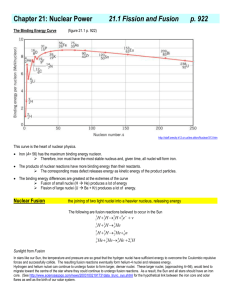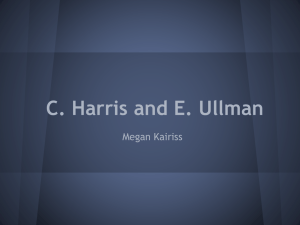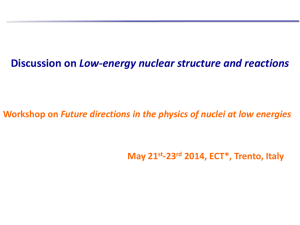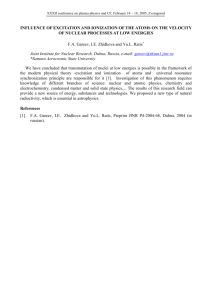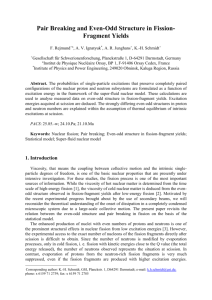Structural effects in nuclide distributions from fission and
advertisement
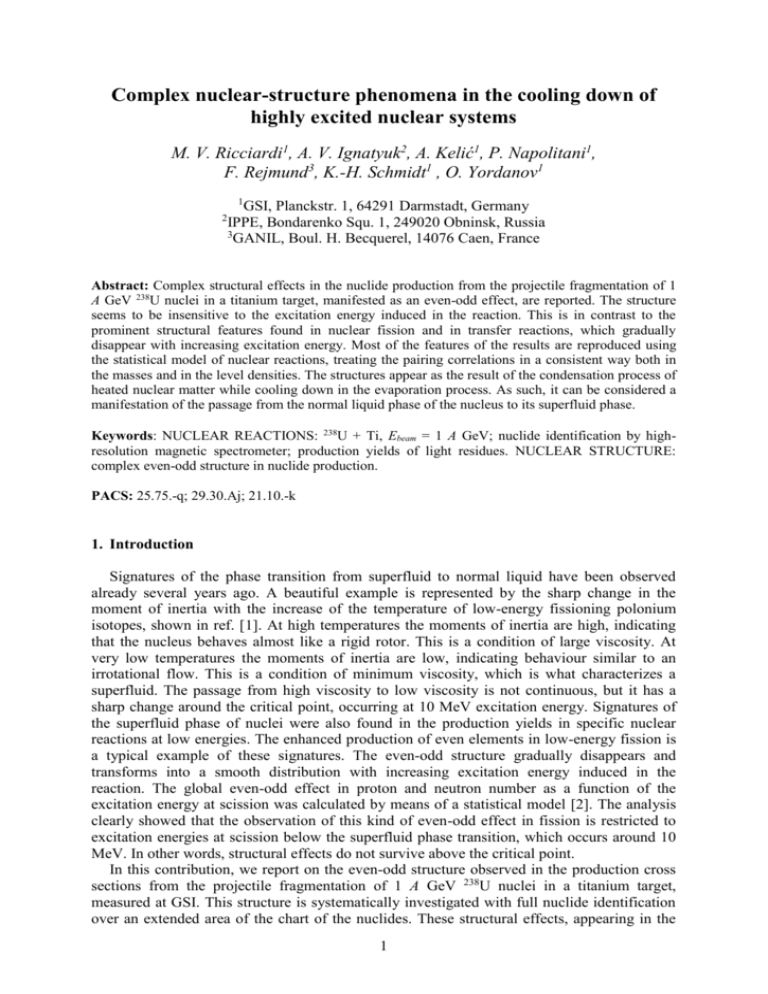
Complex nuclear-structure phenomena in the cooling down of highly excited nuclear systems M. V. Ricciardi1, A. V. Ignatyuk2, A. Kelić1, P. Napolitani1, F. Rejmund3, K.-H. Schmidt1 , O. Yordanov1 1 2 GSI, Planckstr. 1, 64291 Darmstadt, Germany IPPE, Bondarenko Squ. 1, 249020 Obninsk, Russia 3 GANIL, Boul. H. Becquerel, 14076 Caen, France Abstract: Complex structural effects in the nuclide production from the projectile fragmentation of 1 A GeV 238U nuclei in a titanium target, manifested as an even-odd effect, are reported. The structure seems to be insensitive to the excitation energy induced in the reaction. This is in contrast to the prominent structural features found in nuclear fission and in transfer reactions, which gradually disappear with increasing excitation energy. Most of the features of the results are reproduced using the statistical model of nuclear reactions, treating the pairing correlations in a consistent way both in the masses and in the level densities. The structures appear as the result of the condensation process of heated nuclear matter while cooling down in the evaporation process. As such, it can be considered a manifestation of the passage from the normal liquid phase of the nucleus to its superfluid phase. Keywords: NUCLEAR REACTIONS: 238U + Ti, Ebeam = 1 A GeV; nuclide identification by highresolution magnetic spectrometer; production yields of light residues. NUCLEAR STRUCTURE: complex even-odd structure in nuclide production. PACS: 25.75.-q; 29.30.Aj; 21.10.-k 1. Introduction Signatures of the phase transition from superfluid to normal liquid have been observed already several years ago. A beautiful example is represented by the sharp change in the moment of inertia with the increase of the temperature of low-energy fissioning polonium isotopes, shown in ref. [1]. At high temperatures the moments of inertia are high, indicating that the nucleus behaves almost like a rigid rotor. This is a condition of large viscosity. At very low temperatures the moments of inertia are low, indicating behaviour similar to an irrotational flow. This is a condition of minimum viscosity, which is what characterizes a superfluid. The passage from high viscosity to low viscosity is not continuous, but it has a sharp change around the critical point, occurring at 10 MeV excitation energy. Signatures of the superfluid phase of nuclei were also found in the production yields in specific nuclear reactions at low energies. The enhanced production of even elements in low-energy fission is a typical example of these signatures. The even-odd structure gradually disappears and transforms into a smooth distribution with increasing excitation energy induced in the reaction. The global even-odd effect in proton and neutron number as a function of the excitation energy at scission was calculated by means of a statistical model [2]. The analysis clearly showed that the observation of this kind of even-odd effect in fission is restricted to excitation energies at scission below the superfluid phase transition, which occurs around 10 MeV. In other words, structural effects do not survive above the critical point. In this contribution, we report on the even-odd structure observed in the production cross sections from the projectile fragmentation of 1 A GeV 238U nuclei in a titanium target, measured at GSI. This structure is systematically investigated with full nuclide identification over an extended area of the chart of the nuclides. These structural effects, appearing in the 1 residual nuclei produced in a rather violent collision, cannot be attributed to the surviving of nuclear structures at very low energies. We will discuss the reason for this structure and offer our interpretation in the frame of the statistical model. 2. Experimental results The residual nuclei were fully identified in mass and atomic number with the highresolution magnetic spectrometer FRS, and their production cross sections were deduced. More details on the experimental technique and on the data analysis can be found in ref. [3]. In Fig.1, the data are presented according to the neutron excess N-Z. The production cross sections of the observed fragments, grouped according to this filter, reveal a complex structure. All even-mass nuclei present a visible even-odd effect, which is particularly strong for N=Z nuclei. Odd-mass nuclei show a reversed even-odd effect with enhanced production of odd-Z nuclei. This enhancement is stronger for nuclei with larger values of N-Z. However, for nuclei with N-Z=1 the reversed even-odd effect vanishes out at about Z=16, and an enhanced production of even-Z nuclei can again be observed for Z > 16. Finally, all the observed structural effects seem to vanish out as the mass of the fragment increases. A quantitative analysis of the strength of the staggering was performed by means of the equation developed by Tracy [4], which describes the local deviation of the cross sections from a Gaussian-like distribution. In the range covered by the data, the sequence with N=Z shows the strongest effect, reaching values of the order of 50%. Thus, this structure is even stronger than any even-odd structure observed in low-energy fission. Other even-mass nuclei show a much weaker effect, hardly exceeding 10%. For odd-mass nuclei, the intensity of the reversed evenodd effect is strongest for N-Z=5 nuclei (up to 40%). Fig. 1: Measured fragmentation cross sections of the residues from the reaction 238U + Ti, 1 A GeV. The data are given for specific values of N-Z. The cross section for 32Al (Z=13, N=Z+6) is an extrapolated value. The chain N=Z shows the strongest even-odd effect, while the chain N-Z=5 shows the strongest reversed even-odd effect. 3. Analysis with an evaporation model In the last years, a fine structure, manifested as an even-odd effect, was found in the production yields of several deep-inelastic and fragmentation reactions (see table 1 of ref. [3]), which can be quite violent and which are expected to introduce a large amount of excitation energy in the nucleus. Most experiments could determine the nuclear charge of the reaction products, only. Consequently, only the enhancement in the production of even-Z elements, found in the order of a few tens per cent, could be investigated. Lately, with the use of spectrometers, also the neutron number became accessible: the most remarkable finding of 2 these more recent experiments was a variation of the magnitude of this fine structure with the mean neutron excess of the reaction products. Thus, our results are in agreement with the previous findings, but they provide more detailed information. The fine structure in the products of violent reactions can have a two-fold interpretation: or nuclear structure can manifest itself also in the end-products of very hot nuclei, or part of the reaction, by some unknown reason, passes by very low excitation energies. In this work we tested the first hypothesis. The yields of light nuclei produced in the reaction of 238U with Ti at 1 A GeV were calculated with a statistical abrasion-evaporation model, the ABRABLA code, developed at GSI. In ABRABLA, after the nucleus-nucleus interaction, described as an abrasion process, the pre-fragment at every step of its evolution has two possible decay channels: evaporation and fission. The probability that a compound nucleus emits a particle or fissions is ruled by the decay widths. The particle-emission widths and the fission width are calculated as described in ref [5]. Basic ingredients to calculate the widths are the masses (and separation energies) and the level densities. Pairing was included by increasing the binding energies and shifting back the energy levels by 0, or 2, for odd-odd, even-odd or odd-even and eveneven nuclei respectively. To be consistent in the description of pairing effects in the masses and the level densities, we have performed the calculations of the masses and separation energies with the liquid-drop model of Myers and Swiatecki [6] and the pairing gap equal to 12 A for both the masses and the level densities. The results are shown in Fig.2. The most interesting result is the fact that the staggering effects are quite well reproduced by the statistical abrasion-evaporation code. It is important to point out that one would not reproduce the even-odd effects if one would just count the number of final particle-bound states (see ref. [3]). The latter approach would be based on similar assumptions as those used in many thermodynamic models, as for instance in the fission model of ref. [7] which considers the configuration at scission as the relevant "final state" for fission. In order to reproduce the data, the last steps of the evaporation cascade are of primary importance. The final yield is determined by the probability to end up in the states between ground state and separation energy of the final residue. This probability is affected not only by the number of particle bound states, but also by the last steps of the evaporation cascade, and other effects, like the mother-nucleus level density and the competition with gamma emission play an important role (see ref. [3]). Although the gross part of the features of the experimental data could be reproduced using a statistical abrasion-evaporation model, the strength of the staggering in the N=Z chain is underestimated by the simulation code. The results of the calculation were obtained using a well established but rather schematic description of pairing in binding energies and level densities. However there are indications from binding energies and spectroscopy for phenomena which go beyond this simple description. A careful analysis of the experimental binding energies along N-Z=constant chains shows that the N=Z chain shows a considerably enhanced even-odd structure, which is attributed to the Wigner term. Describing the energy of Fig. 2: Production cross sections of fragmentation residues from the reaction GeV, calculated with the ABRABLA code. 3 238 U +Ti at 1 A the excited levels using spectroscopy information one observes a strong even-odd effect in the ground-state energies, which does not completely disappear in the excited levels of the N=Z chain (contrary to the expectation from the superfluid nucleus model). The even-odd staggering in the N=Z nuclei survives up to excitation energies of several MeV above the ground state. The especially strong even-odd effect observed in the N=Z chain could also be related to some peculiar nuclear-structure effects, which go beyond the simple blocking effect of n-n and p-p pairing. These could be for instance alpha clustering, neutron-proton pairing or interplay between pairing and mean-field effects. See ref. [3] for a wider discussion. 4. Conclusions Nuclear structure manifests itself also in the end products of the decay of very hot nuclei. A statistical description of the evaporation cascade could reproduce most of the features of the experimental data, providing that the most prominent manifestation of pairing its blocking effect is taken into account in a consistent way both in the masses and in the level densities. The structures appear as the result of the condensation process of heated nuclear matter while cooling down in the evaporation process. As such they provide interesting information on long-range correlations or clustering in nuclei. The results can be considered as the experimental evidence of the passage from the normal "liquid" phase of the nucleus to its "superfluid" phase. The restoration of the structural properties has to be considered in the measurement of the nuclear temperature by means of the isotope thermometer, and in every technique based on the ratio of the yields of specific isotopes produced in high-energy reactions, like for instance the “isoscaling” method. This method relies on comparing complete isotopic sequences of products emerging from reactions with different reaction partners. In all these approaches, the data have to be corrected for the influence of sequential decay. In this sense, light residues are more appropriate, because the influence of evaporation is less severe as for the heavy ones. However, our data showed the complexity of the structural effects on the yields of these light final products. A statistical evaporation code could reproduce most of the features of the staggering, but the exact quantitative description of the evaporation cascade is still not achieved, in particular for the light N=Z nuclei. Finally, we want to point out the importance of the restoration of the structural properties in astrophysics. The EOS of nuclear matter is relevant for the description of the interior of the neutron stars. Speculations about exotic phases of baryonic matter – including the existence of kaon condensates or quark matter – arose in the last years. However, not only the state of very high density is interesting, but also the crust of the neutron star, which is expected to be in the superfluid phase. The precise knowledge of the pairing gap is essential for the determination of the cooling rate of the neutron stars. The superfluidity of the crust influences the rotation frequency of the star. So, the investigation of the action of the pairing interaction in highly excited systems could turn to be a useful tool also in astrophysics. References 1. 2. 3. 4. 5. 6. 7. A. V. Ignatyuk, K. K. Istekov, G. N. Smirenkin, Sov. J. Nuc. Phys. 36 (1982) 32. F. Rejmund, A. V. Ignatyuk, A. R. Junghans, K.-H. Schmidt, Nucl. Phys. A 678 (2000) 215. M. V. Ricciardi, A. V. Ignatyuk, A. Kelić, P. Napolitani, F. Rejmund, K.-H. Schmidt, O. Yordanov, Nucl. Phys. A 733 (2004) 299. B. L. Tracy, J. Chaumont, R. Klapisch, J. M. Nitschke, A. M. Poskanzer, E. Roeckl, C. Thibault, Phys. Rev. C 5 (1972) 222. J. Benlliure, A. Grewe, M. de Jong, K.-H. Schmidt, S. Zhdanov, Nucl. Phys. A 628 (1998) 458. W. D. Myers, W. J. Swiatecki, Arkiv für Fysik 36 (1967) 343. B. D. Wilkins, E. P. Steinberg, R. R. Chasman Phys. Rev. C 14 (1976) 1832. 4



